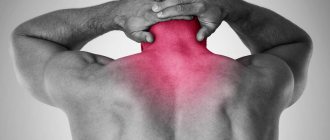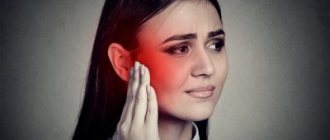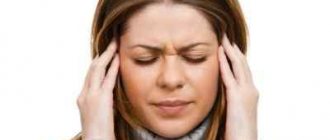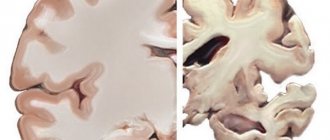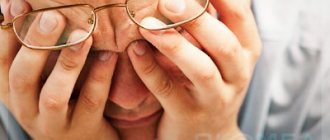Prosopalgia is a collective clinical concept that combines all pain syndromes that occur in the facial area. The complex anatomical and functional organization of the facial structures and nervous system of this area determines the diversity of pathogenetic mechanisms of pain.
Among the latter, we can distinguish compression, inflammatory, and reflex. The great individual significance of the face and increased attention to this part of the human body determines the frequent occurrence of prosopalgia of psychogenic origin. The neurotic component is often layered on top of any pathological processes in the facial area, which should certainly be taken into account in the treatment of facial pain of various natures. Due to its variable etiology, prosopalgia is the subject of supervision of doctors of various clinical specializations - neurology, otolaryngology, ophthalmology, dentistry, psychiatry.
Causes of prosopalgia
An inflammatory reaction can act as an etiofactor of facial pain. Most often, prosopalgia of inflammatory origin occurs with sinusitis. It can be observed in otitis media, ophthalmological diseases (iridocyclitis, uveitis, conjunctivitis, keratitis, corneal ulcer), TMJ arthritis, and have an odontogenic etiology (pulpitis, periodontitis). Prosopalgia can occur with inflammatory lesions of the vessels of the facial area, for example, with Horton's disease. Often, neurogenic prosopalgia has an inflammatory etiology with neuralgia of the glossopharyngeal nerve, trigeminal nerve, Oppenheim syndrome, ganglionitis of the pterygopalatine ganglion, ganglioneuritis of the geniculate ganglion.
On the other hand, neurogenic prosopalgia may have a compression genesis, i.e., arise as a result of compression of nerve trunks or nodes due to changes in the relative position of the anatomical structures of the facial area, narrowing of bone and intermuscular nerve canals, development of tumor formations, etc. Compression etiology may have vascular prosopalgia, for example, carotidynia due to compression of the carotid artery.
The reflex mechanism of pain syndrome is often realized in odontogenic and neurogenic facial pain. The cause of prosopalgia in such cases is pathological reflex impulses coming from chronic infectious foci. An example is neuralgia of the ear ganglion. Myogenic prosopalgia of reflex genesis occurs with myofascial syndromes in the neck and shoulder girdle. Other causes of myogenic prosopalgia may include TMJ dysfunction (Costen syndrome), bruxism, and myofascial syndrome in the masticatory muscles.
Prosopalgia of psychogenic origin often occurs in suspicious, emotionally labile people against the background of overwork, chronic psycho-emotional discomfort, or as a result of an acute stressful situation. Often, psychogenic prosopalgia is observed in persons with hysterical neurosis, neurasthenia, and depressive neurosis. It can occur as part of psychiatric diseases such as schizophrenia, psychopathy, manic-depressive psychosis.
In some cases, prosopalgia is iatrogenic. Thus, Oppenheim syndrome can occur after ophthalmological operations; tooth extraction and other dental interventions can trigger the development of dental plexalgia or atypical odontalgia. One of the causes of neurogenic facial pain is damage to nerve structures during operations in the facial area. In addition, a number of facial pains do not have a clearly established etiology. For example, cluster headache, atypical prosopalgia, chronic paroxysmal hemicrania.
Pathogenesis
The pathogenesis of Pibo is still not clear. Probably, Pibo is a syndrome that covers various etiological factors. For a long time it was believed that psychogenic reasons underlie the development of Pibo.
In addition, a variant of deficiency of the central serotonergic and opioid systems, similar to those in the development of depression, was discussed, but it was subsequently proven that tricyclic antidepressants are effective only in a part of such patients. Many patients have a history of repeated surgical manipulations in the facial area. Repeated surgical interventions can lead to damage to the terminal branches of the trigeminal nerve, and many authors consider Pibo as a variant of phantom pain. On the other hand, what structural damage to the trigeminal nerve contradicts the diagnosis of Pibo. Thus, in this case, the diagnosis of trigeminal neuropathy should be made. Some information about the pathogenesis of Pibo was obtained after performing neuroimaging studies. Thus, SW Derbyshire et al. (1998) patients with this pathology underwent positron emission tomography (PET). Thermal stimulation was used on the dorsal surface of the hand. In patients with Pibo, a significant acceleration of blood flow in the anterior cingulate gyrus and a slowdown in blood flow in the prefrontal cortex were obtained compared with the control group. However, this pattern is not specific; it is interpreted as a hyperemotional reaction in response to received sensory information, indicating a failure of inhibitory systems. Another study, also using PET], found an increase in the density of dopamine D2 receptors in the putamen. During their study, T. Schmidt-Wilcke et al. (2005) conducted morphometry, which showed a decrease in gray matter density in the ipsilateral anterior cingulate gyrus and temporoinsular zone, which is generally characteristic of chronic pain syndromes. The role of vasoneural conflict in the development of Pibo is discussed. In a study by A. Kuncz et al. (2006) found that if vasoneural conflict manifests itself in 66.5% of patients with typical trigeminal neuralgia, then in the group of patients with Pibo, vasoneural conflict is observed only in 3.4% of cases. Among patients with Pibo, surgical decompression was performed in only one patient and was ineffective. An important role in the development of Pibo belongs to the muscular component of the craniomandibular system, which can serve as a source of peripheral sensitization. In a study by H. Didier et al. (2015), which involved 21 patients with Pibo, conducted electromyographic studies of the masseter and anterior temporal muscles during movement and at rest, as well as kinesiography to identify the resting position of the mandible after transcutaneous electrical nerve stimulation. Patients used a splint to correct existing asymmetry. It was found that electromyography (EMG) indices were significantly higher than normal in all muscle groups and returned to normal after electrical stimulation. The study showed that all patients required orthopedic correction, and in 90.5% of cases correction with a splint in the frontal plane was necessary. Comparison of indicators for maximum compression of the natural occlusion with a splint revealed a decrease in the asymmetry of muscle tension (-30.21% for the anterior temporal muscle and -55.81% for the masseter muscle) and a diffuse increase in muscle strength (left anterior temporal muscle + 25.37% ; left masseter muscle + 59.40%; right masseter muscle + 40.80%; right temporalis muscle + 30.27%). In addition, a diffuse decrease in pain intensity from 9.5 to 3.1 points on VAS was found. Thus, Pibo is today considered as a polyetiological syndrome, including a myogenic or iatrogenic source of peripheral sensitization in the facial area, insufficiency of central pain systems, as well as the presence comorbid emotional and affective disorders.
Classification of prosopalgia
Facial pain is classified primarily by mechanism of development. Prosopalgia is distinguished:
- vascular
- neurogenic
- myogenic
- psychogenic
- symptomatic
- atypical
- painful ophthalmoplegia
Vascular facial pain
includes:
- bundle cephalalgia
- paroxysmal hemicrania
- Horton's disease
- idiopathic sudden cephalalgia (ISH)
- SUNCT syndrome.
Neurogenic prosopalgia
includes:
- trigeminal neuralgia
- neuralgia of the glossopharyngeal nerve
- ganglionitis and ganglioneuritis of the nerve ganglia of the facial region.
Symptomatic facial pain
. Depending on the etiology, symptomatic prosopalgia is divided into
- ophthalmogenic
- odontogenic
- otorhinogenic
- viscerogenic.
To atypical
include pain that does not fit into the clinical picture of any of the types of prosopalgia specified in the classification. They are often caused by a combination of several pathogenetic mechanisms and have a psychogenic component.
Nociceptive pain
The most common causes of nociceptive facial pain are diseases of the teeth and periodontal tissue [5, 21]. Odontogenic pain is one of the most common and painful. It is capable not only of irradiation, but also of repercussion (reflection into other zones). Few dental diseases are chronic, but given their high prevalence, they should be diagnosed in patients with chronic facial pain [22, 23].
Thus, it is known that when a wisdom tooth is damaged or even difficult to erupt, pain can be felt in the ear and the TMJ area. When the molars of the upper jaw are affected, pain may occur, spreading to the temporal region and upper jaw. Damage to the molars of the lower jaw can cause pain reflected in the area of the larynx and crown, the sublingual area. With pathology of the incisors, pain is usually reflected in the area of the nose and chin [24]. Intraoral pain not associated with dental tissues also occurs (in case of damage to the oral mucosa, tongue, or periodontal tissue). Cases of nerve injury due to either dental procedures or trauma have been reported in the literature. Recently, an international group of experts proposed the use of the term “persistent dentoalveolar pain disorder” to classify persistent pain without local disease (other names such as “atypical odontology” or “phantom toothache” are also found) [25]. Terms such as post-traumatic trigeminal neuropathy, peripheral painful traumatic trigeminal neuropathy may be used in cases where there is a clear correlation between the injury and the development of pain [21].
Clinical features
Facial pain of various origins differs in its clinical features regarding the nature, duration, paroxysmalness, and vegetative coloring of the pain syndrome. These distinctive features, as well as accompanying symptoms (if any), enable the neurologist to determine the type of prosopalgia, which is fundamental in the diagnosis and subsequent treatment of facial pain.
The permanent (constant) type of pain syndrome is more typical for myogenic, psychogenic and symptomatic prosopalgia. It may occur with episodes of increasing and decreasing pain. Paroxysmal pain phenomenon with intense painful attacks of variable duration against the background of complete or almost complete absence of pain in the interictal period is typical for neurogenic and vascular prosopalgia. A distinctive feature of the latter is the presence of a pronounced vegetative component - during paroxysm, swelling, lacrimation, hyperemia of the skin area, rhinorrhea, nasal congestion, redness of the conjunctiva, etc. are observed.
Bilateral in nature, as a rule, is symptomatic, myogenic and psychogenic prosopalgia. Moreover, the latter may be distinguished by the asymmetry of the pain phenomenon in the halves of the face. Vascular, neurogenic and atypical facial pain is usually unilateral.
Irradiation of pain is more typical with neurogenic and vascular prosopalgia, but can also be observed with facial pain of symptomatic origin. In addition, symptomatic prosopalgia is often reflexive in nature. The most illustrative example is odontogenic prosopalgia, caused by the occurrence of pain in the Zakharyin-Ged zones: mandibular, nasolabial, maxillary, frontonasal, temporal, sublingual, mental, laryngeal. Each zone is a reflection of the pathology of certain teeth, while toothache may be absent.
Rubric “FACIAL PAINS, THEIR CLASSIFICATION”
The face has extremely extensive both animal (somatic) and autonomic innervation. Sympathetic innervation of facial tissues is provided by postganglionic fibers - axons of cells whose bodies are located in the ganglia of the cervical section of the paravertebral sympathetic chain. Parasympathetic innervation is carried out by postganglionic processes of neurons located in the autonomic ganglia of the face (ciliary, pterygoid, auricular, submandibular, sublingual), as well as in the geniculate ganglion. These ganglia are associated with the parasympathetic nuclei of the brain stem, which are part of the system of some cranial nerves (oculomotor, facial, glossopharyngeal). Sympathetic, parasympathetic and somatic fibers form mixed facial nerves with numerous anastomoses. Therefore, irritation of the nervous structures of the face in most cases is accompanied by pain, radiating to a considerable distance from the zone of irritation, and various manifestations of autonomic dysfunction. Damage to the nervous structures of the face can be of various origins. More often these are infectious-allergic disorders, usually secondary, arising from the development of a chronic infectious process in the facial tissues (inflammation in the sinuses, dental pathology, diseases of the salivary glands, middle ear, etc.). The cause of vegetative facial pain can also be injuries, tumors, etc. With a long course of vegetative prosopalgia, patients develop asthenodepressive and hypochondriacal disorders. The following are some variants of vegetative facial pain (vegetative prosopalgia). Nasociliary nerve syndrome (nasal nerve syndrome, Charlin's neuralgia, Oppenheim's neuralgia). Clinical manifestations. There are attacks of excruciating burning pain in the area of the orbit, eyebrow and especially in the medial canthus and in the corresponding half of the nose, accompanied by swelling, hyperesthesia, hypersecretion of tears and nasal secretions, hyperemia of the skin, mucous membranes, injection of scleral vessels, sometimes iridocyclitis, keratitis. During attacks, photophobia on the affected side, pain on palpation of the inner corner of the eye, and possible bruising in the affected area are common. Middle-aged people get sick more often. May be a complication of sinusitis. The attack lasts from 30 minutes to 2 hours, rarely more. During an exacerbation, attacks can occur daily, and sometimes 2-3 attacks per day. More often, attacks occur at night and in the morning. Bilateral pain paroxysms are possible. Between series of attacks there may be long remissions. Described in 1931 by the Chilean ophthalmologist S. Charlin (born in 1886). Sometimes it must be differentiated from cluster headache. Treatment. Non-steroidal anti-inflammatory drugs (diclofenac, piroxicam, meloxicam, etc.) are used. For attacks, non-narcotic analgesics are prescribed, carbamazepine up to 800 mg per day, 0.25% di-caine solution in the conjunctival sac. Lubricating the mucous membrane of the upper nasal passage with a 2% solution of cocaine along with 3-5 drops of a 0.1% solution of adrenaline. A turunda moistened with an anesthetic on a probe is inserted into the upper nasal passage and left for 5-10 minutes. Neuralgia of the ear node. Clinical manifestations. Burning paroxysmal pain in the temporal region is noted in front of the external auditory canal, radiating to the lower jaw, chin, sometimes to the teeth, hypersalivation is observed on the side of the pathological process, and a feeling of ear congestion occurs. The attack lasts from several minutes to 1 hour. It can be provoked by eating hot or cold food, hypothermia, or pressing on the point between the external auditory canal and the temporomandibular joint. It usually occurs against the background of an inflammatory focus in nearby tissues (with tonsillitis, sinusitis, diseases of the dentofacial system). Treatment. Sometimes an attack of pain can be stopped with novocaine blockade of tissue at the point between the external auditory canal and the temporomandibular joint. It is necessary to treat the underlying disease. Neuralgia of the pterygopalatine ganglion (pterygopalatine ganglion syndrome, Slader's syndrome). Clinical manifestations. Neuralgia of the pterygopalatine ganglion manifests itself as paroxysmal intense burning, aching, bursting pain in the upper jaw, in the nose, radiating to the area of the inner corner of the eye and is accompanied by local vasomotor and secretory reactions, in particular copious nasal secretions, lacrimation, hyperemia of the skin and mucous membranes, tissue edema persons on the side of the pathological process. A common form of paroxysm is possible, with pain and autonomic reactions covering half of the face, head, neck, sometimes spreading to the arm and shoulder girdle. If there are no organic neurological symptoms in the interictal period, then the form of the disease is ganglioneuralgic. In some cases, attacks of pain occur against the background of permanent local unilateral pain and tenderness in the area of the upper jaw, nose and vegetative-vascular disorders in the form of injection of conjunctival vessels, hyperemia and swelling of the mucous membrane of the nose and upper jaw, swelling of the cheek, and sometimes signs of Horner's syndrome - This is the ganglioneuritic form. Pain and autonomic disorders are obviously caused by irritation of the pterygopalatine ganglion, the release of tissue biologically active substances - serotonin, histamine, kinins. Repercussive nervous mechanisms, as well as the accumulation of biogenic amines and neurokinins in the blood can cause the development of generalized vegetative-vascular reactions, often of a mixed nature. In this regard, during an attack, dizziness, nausea, and suffocation are possible. An attack of pain usually lasts about an hour, sometimes several hours. The disease was described in 1908 by the American otorhinolaryngologist G. Sluder (1865-1925). Treatment. Complex treatment requires sanitation of the oral cavity, nasopharynx, and treatment of sinusitis. To relieve a painful attack during neuralgia of the pterygopalatine ganglion, lubricate the mucous membrane of the lateral wall of the cavity of the middle nasal meatus with a 3-5% solution of cocaine or other local anesthetic. It is advisable to administer an intravenous infusion of a mixture including 2 ml of a 50% solution of analgin, 2 ml of a 1% solution of diphenhydramine, 10 ml of a 1% solution of trimecaine, or intramuscular injection of 2 ml of a 0.25% solution of droperidol, 2 ml of a 0.005% solution of fentanyl. In the interictal period, in order to prevent subsequent paroxysms, the mucous membrane of the middle nasal passage is repeatedly lubricated with cocaine (up to 10 days), antihistamines and adrenergic agonists are prescribed orally (ergotamine 1 mg 2 times a day for 3-4 weeks, with every week - break for 3 days), antispasmodics, NSAIDs, solutions of vitamins B and B12 are administered intramuscularly). In case of exacerbation of the disease, physiotherapeutic treatment is indicated, in particular intranasal electrophoresis with a 0.5% solution of novocaine, tranquilizers; acupuncture. If treatment is ineffective, the issue of radiotherapy or surgical treatment (gangliectomy) is decided. Auriculotemporal syndrome (neuropathy of the auriculotemporal nerve, Frey syndrome, Baillarger-Frey syndrome). Clinical manifestations. Autonomic prosopalgia is manifested by burning, aching, throbbing pain in the temple area, in the ear, in the area of the mandibular joint, often radiating to the lower jaw. A mandatory manifestation of an attack is skin hyperemia and increased sweating in the parotid-temporal region. The occurrence of attacks is usually provoked by eating, physical work, general overheating, smoking, and sometimes emotional stress. Auriculotemporal syndrome can be a complication of purulent parotitis, accompanied by destruction of the parenchyma of the parotid salivary gland and damage to the auriculotemporal nerve innervating it. In this regard, both reflex and humoral salivation of the parotid salivary gland is disrupted. Hyperhidrosis in the parotid region during eating is typical. French doctors described auriculotemporal syndrome: in 1847 - K. Beillarger and in 1923 - L. Frey. Treatment. Anticholinergics are recommended: atropine 0.5 mg or platyphylline 5 mg 3 times a day before meals. A lidase solution of 1 ml (64 units) is injected subcutaneously for 10-15 days. Electrophoresis of lidase or potassium iodide, paraffin baths, and mud therapy are performed on the area of the parotid gland. Gangliopathy of the submandibular and sublingual nodes. Clinical manifestations. It appears extremely rarely. The etiology appears to be varied. Usually these are local inflammatory processes of the maxillofacial localization, traumatic lesions of the autonomic nodes, in particular, due to surgical interventions. Gangliopathy of the submandibular ganglion is characterized by constant aching pain in the mandibular region, against which paroxysms of acute pain with a vegetative component lasting from 10 minutes to several hours are possible. During an attack, pain radiates to the sublingual area, corresponding to half of the tongue. Hypersalivation is common, and a feeling of dry mouth is less common. The presence of a painful point in the submandibular triangle is characteristic. When the sublingual node is affected, a similar clinical picture is observed, however, pain is noted mainly in the sublingual area and radiates mainly to the tip of the tongue. The painful point is usually identified medial to the mandibular ridge. More common is a combined lesion of both autonomic ganglia. The localization of pain depends on the predominant damage to one or another node. There is no connection between pain and food intake. During the course of the disease, dystrophic changes in the mucous membrane in the anterior 2/3 of the tongue may appear, such as desquamative glossitis, taste disturbances, and increased muscle fatigue of the tongue may occur. Psycho-emotional disorders and hypochondriacal fixation are common. Treatment. Sanitation of the oral cavity is necessary (complicated dental caries, periodontitis, pathology of the salivary glands.). Pathogenetic treatment is carried out: anticholinergics (primarily ganglion blockers), antihistamines and desensitizing agents, biostimulants, vasodilators. Additional treatment: NSAIDs (diclofenac, etc.), tranquilizers, anti-depressants, physiotherapy. General recommendations for the treatment of vegetative prosopalgia. For all forms of vegetative prosopalgia indicated in this section in cases of neuralgic attacks, the use of carbamazepine or other antiepileptic drugs, which usually have a membrane-stabilizing effect and inhibit the spread of impulses from the focus of pathologically high excitation, is indicated. To maintain a longer remission, it is advisable to change antiepileptic drugs every 5-6 months; sometimes it is necessary to resort to a combination of them. For non-paroxysmal (permanent) facial pain, antiepileptic drugs are usually ineffective. In such cases, NSAIDs are used. Their analgesic effect is enhanced by taking antidepressants, tranquilizers, barbiturates, antihistamines, and physiotherapeutic treatments. 28.3.3. Other prosopalgia Cold facial pain. Clinical appearances. Significantly intense pain in the fronto-orbital region is always provoked by cooling the head or neck. Cooling can be a consequence of being in the cold or swimming in cool water. Sometimes a painful attack can be triggered by drinking cold drinks or ice cream. To clarify the diagnosis, it may be essential to compare the information obtained from Doppler sonography and especially from thermal imaging examination during periods of normal well-being of the patient and during attacks of prosopalgia. N. Wolf (1981) and I.D. Stulin (1981) explain the occurrence of cold facial pain by spasm of the branches of the carotid arteries due to the increased sensitivity to cold of the receptors of the carotid sinuses, which are adjacent to the larynx on both sides. After cooling stops, the pain disappears within 15-20 minutes. At the same time, ultrasound and thermographic data are normalized. Treatment. Antispasmodics, analgesics, and thermal procedures are prescribed. For the purpose of prevention, it is advisable to avoid cooling and drinking chilled drinks and ice cream. Painful dysfunction of the temporomandibular joint (Costen syndrome). The temporomandibular joint is involved in chewing, swallowing, and articulation. Its sensitive innervation is carried out mainly by the branches of the trigeminal nerve, but branches of the lesser occipital nerve, as well as the vagus nerve, which connects with the branches of the glossopharyngeal nerve, also take part in this process. Movements of the lower jaw are provided mainly by the masticatory muscles, innervated by the motor portion of the third branch of the trigeminal nerve. The peculiarities of the innervation of the joint determine the nature of pain irritation. Joint damage is provoked by incorrect dental bite, dental pathology, periodontal disease, trauma, inflammatory processes in the dental-maxillary system, in which the chewing load is unevenly distributed. The cause of pain in the temporomandibular joint can be a pathological overload of the masticatory muscles, their spastic state accompanied by ischemia, degenerative changes in the joint, arthrosis, and backward displacement of the articular head or disc, leading to compression of the joint capsule. The development of organic changes in the joint can be facilitated by prolonged tension in the masticatory muscles due to psycho-emotional disorders and bruxism (Krestina A.D., 1991). Clinical manifestations. Costen's syndrome is characterized by constant pain in the temporomandibular joint, aggravated by eating and talking. The pain radiates to the ear, temple, submandibular region, and neck. When moving the lower jaw, there may be a clicking sound, a crunching sound in the joint, and sometimes limited movements of the lower jaw. The ability to open the mouth is limited, and there is a displacement of the lower jaw to the side. If the mouth is closed, palpation of the joint is usually painless, but the muscles of mastication, especially the lateral pterygoid muscle, may be painful. Pain sensitivity of the skin of the face and oral mucosa is not changed. EMG usually reveals asymmetry in the activity of the masticatory muscles. Treatment. It is necessary to find out the cause of painful dysfunction of the temporomandibular joint and take possible measures to eliminate it. Dental treatment, elimination of malocclusion, performing special exercises aimed at relaxing the masticatory muscles, and their blockade with novocaine are usually indicated. Among the medications, diazepam (seduxen, sibazon, relanium), muscle relaxants (mydocalm, baclofen), NSAIDs, antidepressants are advisable. Facial massage, acupuncture therapy, and physiotherapy are indicated. Glossalgia, stomalgia. Local and general causative factors play a role in the occurrence of almost constant pain and paresthesia in the tongue and oral mucosa. Local causes are varied (mechanical, physical, chemical), among them - irritation of the oral mucosa by the sharp edges of defective teeth, poor-quality dentures, and tartar deposits. The cause of discomfort and pain in the mouth can be galvanosis - various metals used in prosthetics, as well as allergic reactions to dentures made of acrylic plastic, complete or partial adentia, tooth wear, consequences of post-injection complications, traumatic tooth extraction, mucosal diseases membranes of the mouth (candidiasis, lichen planus). Many authors attach primary importance to diseases of the digestive system (chronic gastritis, enterocolitis, peptic ulcer of the stomach and duodenum, hepatocholecystitis) in stomalgia and glossalgia. Diabetes mellitus and menopause are also considered possible causes of stomalgia and glossalgia. In such cases, disturbances of somatovisceral impulse affect the structures of the trigeminal system, which is directly related to the innervation of the tongue, which is reflected in an increase in its sensory excitability. Manifestations of pain in the tongue and oral mucosa can be provoked by psychotraumatic situations (Vinokurova V.D. et al., 1991). Characteristic pain and paresthesia (burning, rawness, distension) with glossalgia - in the tongue, with stomalgia - in the gums, mucous membrane of the oral cavity, and sometimes the pharynx. The severity of these sensations can be different (sometimes they are painful) and changes throughout the day. Pathognomonic for stomalgia and glossalgia is a decrease or complete disappearance of pain while eating. They most often appear between the ages of 35 and 55, and sometimes occur in children. Treatment. They carry out sanitation of the oral cavity, treat diseases of the digestive tract, prescribe sedatives, tranquilizers, antidepressants, use acupuncture, and psychotherapy.
Read more
Diagnosis of prosopalgia
In most cases, facial pain in itself is not a diagnosis, but rather a syndrome. In this regard, it is important to identify/exclude the underlying disease that caused prosopalgia. During diagnosis, a neurologist-algologist carefully studies the various characteristics of the pain phenomenon, palpates the facial muscles, and identifies trigger points (places of intense palpation pain). The exclusion/confirmation of the symptomatic nature of facial pain is carried out with the participation of an ophthalmologist, dentist, and otolaryngologist.
If necessary, dental x-rays, orthopantomograms, x-rays of the paranasal sinuses and the temporomandibular joint, otoscopy and pharyngoscopy, measurement of intraocular pressure, examination of eye structures, etc. are performed. In order to identify inflammatory changes, a clinical blood test is prescribed. Psychogenic and atypical prosopalgia are an indication for consultation with a psychiatrist or psychotherapist with psychological testing and pathopsychological examination.
Preventive measures
It is much easier to prevent facial pain from occurring than to deal with it later. For this purpose, prevention is carried out, which will help not only maintain well-being, but also prevent the occurrence of negative symptoms. A person is advised to adhere to specific medical recommendations to reduce the likelihood of left-sided prosopalgia.
First of all, you will need to undergo annual preventive examinations so that abnormalities in the body can be detected in time. In this case, they will be able to be cured in time and prevented from progressing. It is imperative to strengthen the immune system, then you will be much less likely to encounter infectious and inflammatory diseases. They quite often lead to the appearance of pathology.
It is worth avoiding hypothermia if possible, because in such a situation prosopalgia may develop. If an ear or toothache appears, then you need to start treatment on time, and not wait until the condition worsens significantly and the pain syndrome spreads to the face. The longer a person puts off visiting the doctor, the worse his health will become. The disease will gradually progress and cause new negative symptoms.
As soon as unpleasant sensations appear in the face, it is recommended to consult a specialist. After examination, he will be able to clearly say what exactly the person had to face. Once the diagnosis is correct, the person can begin effective therapy. It will allow you to quickly get rid of negative symptoms and generally improve your well-being.
Treatment of prosopalgia
Treatment of facial pain depends entirely on its etiology. Symptomatic prosopalgia first of all requires treatment of the underlying disease - otitis media, sinusitis, pulpitis, etc. With inflammatory genesis, neurogenic, vascular and myogenic prosopalgia are treated by prescribing anti-inflammatory medications (diclofenac, indomethacin, ibuprofen, nimesulide, etc.).
To relieve pain at trigger points, therapeutic blockades with the administration of corticosteroids and local anesthetics can be performed. For trigeminal neuralgia, the use of carbamazepine is effective, for ganglionitis - ganglion blockers (benzohexonium, pentamine), for Horton's disease - corticosteroids (prednisolone). Physiotherapeutic methods are additionally used for anti-inflammatory purposes: hydrocortisone ultraphonophoresis, DDT, magnetic therapy, electrophoresis.
Therapy for facial pain of compression origin, in addition to anti-inflammatory treatment, includes vascular (nicotinic acid, aminophylline) and decongestants (antihistamines, diuretics) and vitamins. B. Failure of conservative therapy is an indication for surgical treatment (for example, microsurgical decompression of the trigeminal nerve). Persistent prosopalgia in ganglioneuritis is an indication for removal of the affected ganglion; in trigeminal neuralgia, in such cases, a measure of temporary pain relief is radiofrequency destruction of the trigeminal nerve root.
In many cases, a mandatory component of the treatment of facial pain is sedative therapy: soothing herbal preparations, mild tranquilizers (mebicar), antidepressants (St. John's wort extract, fluvoxamine, sertraline). If necessary, vegetotropic agents are prescribed (belladonna alkaloids + phenobarbital, belladonna extract). Therapy for psychogenic prosopalgia is carried out using psychotherapy methods and psychotropic drugs selected in accordance with the clinical characteristics: tranquilizers, neuroleptics, antidepressants. Electrosleep and darsonvalization are indicated.

